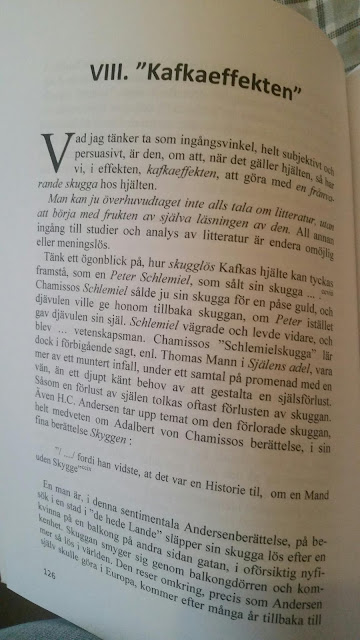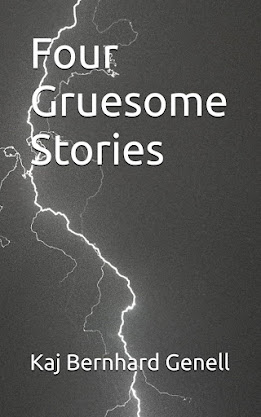( tänkerjagdå ) Mitt namn är Kaj Bernh. Genell. Jag är en göteborgare, född 1944. Jag skriver en del o. har bland annat skrivit romaner, flera deckare, noveller, en bok om Kafka, samt en bok om Ironi. Flera romaner är på engelska. Böckerna finns på Adlibris, Bokus. Vissa finns enbart på Amazon. Läs gärna mer på mina hemsidor: www.kajgenell.com & www.tegelkrona.com Jag är - vad gäller littertur - emot det pretentiösa, men för det preciost ironiska.
fredag 12 oktober 2018
torsdag 11 oktober 2018
onsdag 10 oktober 2018
Franz Kafka and the Kafkaesque.
Franz
Kafka and the Kafkaesque.
The work of mine displays a
distinct answer to the question regarding the uniqueness of Kafka and regarding
the concept of the kafkaesque and how Kafka managed to achieve this very
effect of the Kafkaeasque through his special technique. My work is an attempt
to look for the meaning of the use of the kafkaic style. The uniqueness of the kafkaesque
is noticed by many others but here it is explained by reference to the
process of creation of it. Through the years this
explanation has been missing.
Kafka uses two unconscious levels in
his major works. Sholars like W. Benjamin, Th. Adorno, M. Walser and H. Hiebel
have noticed the extraordinary experienced qualities of the kafka text, the strange features owned
by the hero, the hero as a mere figure
and the “dream-like” universe. But I am displaying a model that can bring these
features into a dynamic scheme, explained from an author´s ( albeit unconscious
) view.
Now – for the first time – the veil of
mystery can be lifted with concern to these classical works of Modernity.
It is in fact essential for Modern Man to be
aware of this technique, to be able to reflect on the picture of Modern Man. Kafka
was part of the creation of THE self-conscience in the 20ieth century, marked
by a constant dialogue with Freud and his works. Self-conscience as Man knew it
since St. Augustine, the Italian renaissance writers, Erasmus, Shakespeare and
Montaigne and later with the secular Romantics and Hegel, swiftly in Modrnism developed
into something much more complex with the appearance of Freud and the
publication of the Traumdeautung in
the year of 1900. And Kafka fulfilled it all.
Kafka appeared as a reaction to
1.) Modern times, to 2.) his own personal alienation and to 3.) Freud. Kafka´s
answer to Modernity – to the modern condition – was an astonishingly complex
one, but it turned out to be very accurate and accomplished right from the very
beginning. When other reactions to the modern condition, like Dada, displayed a
picture of a chaotic and a rebel attitude to reason and morals, Kafka, like
Rimbaud, showed a far more complex ability to encompass the soul of humans in
relation to the Modern society in a universal form.
Kafka´s relation to Freud was
somewhat like that of a relation of a son to the father. Thus Kafka did not
acknowledge Freud´s discoveries, interpretations, methods and notions as
truths. But he saw them – ironically – as facts. And in a sense they were.
Freud´s views were historical facts in their deep influence on mind and society
of the century. Hence Kafka used Freud as part of the Modern Myth.
FK did not “believe in” Freud,
but he was fascinated by him. He did not study Freud at great extent, but he
had – as many – acquired an immediate understanding of his ideas, through
everyday osmosis.
Kafka started out as a writer of
lyrical prose, short prose poems. But his dream was to write a novel, and it
should be a novel like the one Flaubert ( Kafka´s literary idol ) wanted to
write: a very beautiful book about nothing at all. It also seems as he wanted
to develop the style of Tieck and the Romantics. So it turned out that Kafka
now developed a technique for writing novels where he was extending a sole
situation into a perfectly static ( i.e. nothing ) drama displaying a struggle
between conscious and unconscious. Using his extraordinary ( perhaps autistic )
sensibility his technique, the kafkaic, miraculously was born in 1912 with the
writing of the short story of The Verdict.
He asked his fiancée Felice for the meaning of it.
Later, with the writing of the unfinished
The Process, his technique of
displaying the Kafkaesque was already full-fledged. Here he – almost FORCE by
his own personal and social catastrophe - introduced a pseudo plot in a kind of
pseudo novel displaying a story of a
split, a struggle of a conscious instance of a person, shown as a
hero-figure battling this person´s OWN unconscious. As it turned out, this
battle originated – caused - a second unconscious part to appear in the
universe of this fiction. It seems that the hero-figure,
devoid of his unconscious, HAD TO develop such an unconscious to be able to
handle his surrounding world, which was his original unconscious. Here we thus
are having a triadic structure and a
strange meeting of two unconscious instances.
This fictional condition primarily results in
a double exposure of the unconscious and secondly in a strange transcendence of
the Ego, which cannot easily be reflected upon, since it has no equivalent in
reality.
As a result of this kafkaic technique,
which probably was unconscious (!) to Kafka himself, we are also – apart from
the nausea of double unconscious, a kind
of the self-consciousness of the unconscious - experiencing a very intense
poetry displaying utter loneliness and in a framwork : a sad pseudo-protest
against the super power of civil organization and law in general as well as a melancholy
beauty of existence. The like of which never again has been created.
Prenumerera på:
Inlägg (Atom)
-
KAPITEL TJUGOFYRA AVBRUTET FRIERI På onsdagen – som nu kommit - hade Slim och Sofi sedan en vecka tillbaka planerat att göra...
-
KAPITEL TJUGOTRE EN LÅNG NATT Efter det att Herbert och Nils tagit en runda runt Boxeby och kommit in i salongen igen, d...
-
KAPITEL ARTON Klarinettrummet När Pannhäuser lämnat Liselott och de andra i köket för att återvända till Henrik för ...






